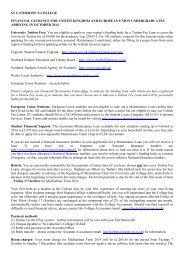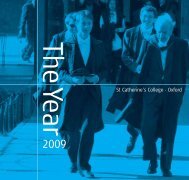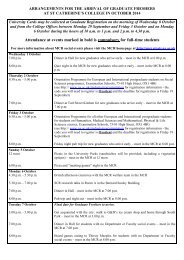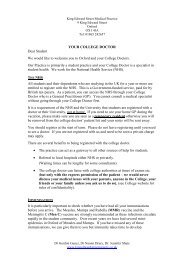Download PDF - St. Catherine's College - University of Oxford
Download PDF - St. Catherine's College - University of Oxford
Download PDF - St. Catherine's College - University of Oxford
Create successful ePaper yourself
Turn your PDF publications into a flip-book with our unique Google optimized e-Paper software.
MESSAGES<br />
© The World Bank<br />
Dr Jim Yong Kim, President <strong>of</strong> the World Bank, at the launch <strong>of</strong> Sudhir Anand’s The Cost <strong>of</strong> Inaction, 19 December 2012<br />
because the costs <strong>of</strong> inaction tend to be<br />
large. The negative consequences <strong>of</strong> inaction<br />
in relation to children are experienced over<br />
a long period <strong>of</strong> time – their entire lifespan.<br />
Obversely, the benefits <strong>of</strong> investment in<br />
children are reaped over a long time horizon.<br />
Investments in children’s early development,<br />
nutrition, health, and education will therefore<br />
generate large aggregate benefits – as<br />
demonstrated in the Rwanda and Angola case<br />
studies.<br />
There is another reason why the costs<br />
<strong>of</strong> inaction in relation to children can be<br />
particularly large. The damage caused by<br />
not undertaking certain actions on behalf<br />
<strong>of</strong> children may be irreversible. Thus if a<br />
child suffers from severe malnutrition, he<br />
or she can become stunted – a condition<br />
that is difficult to reverse. If damage is done<br />
to neural networks, it is almost impossible<br />
to undo. Finally, the death <strong>of</strong> a child<br />
through inaction is the ultimate irreversible<br />
consequence.<br />
The case studies in the book focus mainly<br />
on children affected by poverty and HIV/<br />
AIDS. But the COI approach is quite general<br />
and can be applied to other areas. Failure<br />
to act on climate change, for instance, will<br />
lead to enormous costs because the period<br />
<strong>of</strong> time (in this case, generations) over<br />
which the consequences are experienced is<br />
very long, and many <strong>of</strong> the consequences<br />
are irreversible – or reversible only at great<br />
cost.<br />
In summary, the COI approach provides a<br />
framework to support the evaluation <strong>of</strong> the<br />
negative consequences <strong>of</strong> inaction. Difficult<br />
decisions have to be made by policymakers,<br />
and there is no mechanical formula that can<br />
generate decisions. Many value judgments<br />
must be taken into consideration in the<br />
areas <strong>of</strong> human and economic development.<br />
People’s values <strong>of</strong>ten differ, and there<br />
needs to be room for debate. The COI<br />
approach seeks to promote such discussion,<br />
not to avoid it. n<br />
‘Economists tend to speak<br />
as if –or at least build<br />
models that embody the<br />
idea –most things in life<br />
are flexible, adjustable<br />
and reversible. But much<br />
<strong>of</strong> life is not like that and<br />
this observation is crucial<br />
for policy. That is why the<br />
concept <strong>of</strong> the cost <strong>of</strong><br />
inaction is so important<br />
and why this thoughtful<br />
and scholarly book is so<br />
valuable’<br />
Pr<strong>of</strong>essor Lord <strong>St</strong>ern <strong>of</strong><br />
Brentford,<br />
Honorary Fellow<br />
© The World Bank<br />
ST CATHERINE’S COLLEGE 2012/51
















